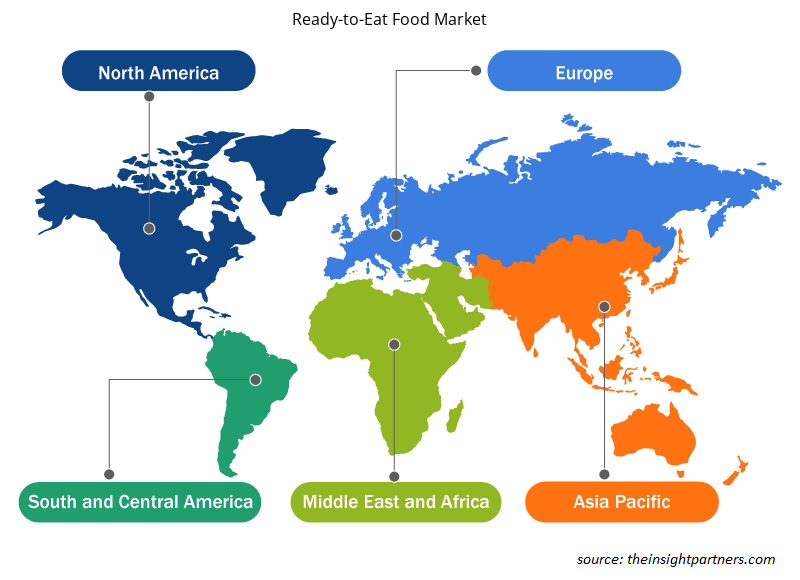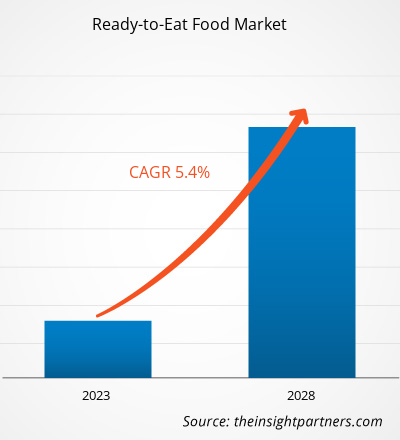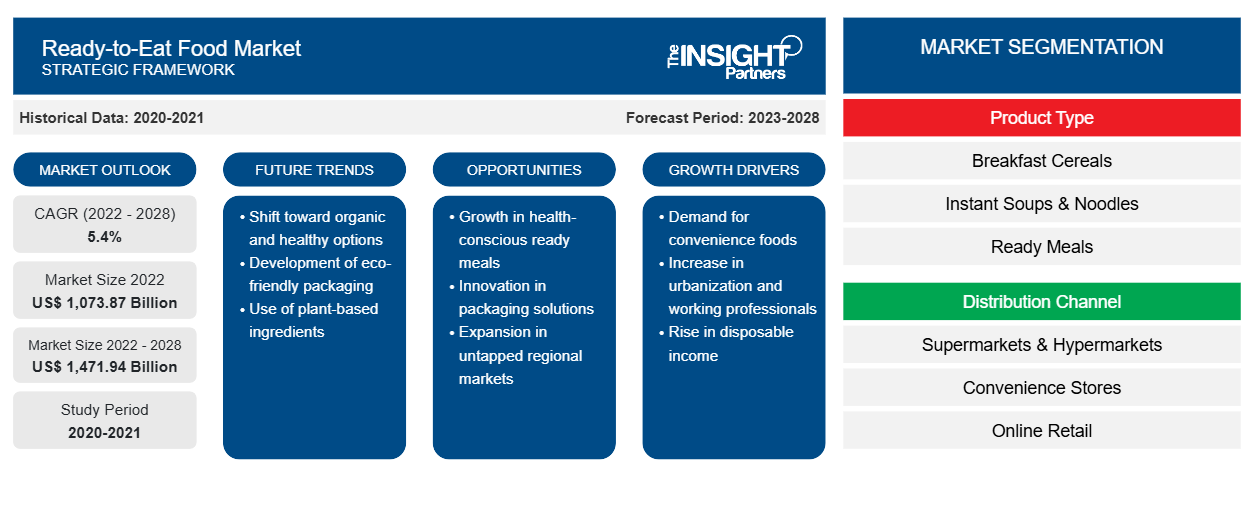[Rapporto di ricerca] Si prevede che il mercato degli alimenti pronti al consumo raggiungerà 1.471,94 miliardi di dollari entro il 2028, rispetto ai 1.073,87 miliardi di dollari del 2022. Si prevede che crescerà a un CAGR del 5,4% dal 2022 al 2028.
Il cibo pronto al consumo è costituito da vari alimenti trasformati e confezionati che possono essere consumati senza ulteriore preparazione. Gli ingredienti vengono lavati, cotti, trasformati e confezionati in contenitori per il consumo diretto. Alcuni tipi comuni di alimenti RTE includono zuppe istantanee, prodotti da forno, dessert e pasti pronti. Questi prodotti sono arricchiti con vari estratti, acidi, aromi, dolcificanti , antiossidanti e conservanti. Offrono un'immensa praticità al consumatore, aiutando nel contempo a ridurre i tempi di preparazione dei pasti e a garantire una maggiore durata di conservazione dei prodotti, un'efficienza dei costi e un deterioramento minimo.
L'Asia Pacifica ha detenuto la quota maggiore del mercato degli alimenti pronti al consumo nel 2020, mentre altre regioni in via di sviluppo, come Medio Oriente e Africa, dovrebbero crescere in modo significativo nel periodo di previsione. I principali attori che operano nel mercato degli alimenti pronti al consumo stanno espandendo le loro attività in tutta l'Asia Pacifica a causa dell'aumento della popolazione attiva e degli stili di vita frenetici delle persone nei paesi in via di sviluppo. Gli individui stanno sempre più optando per il consumo di cibo in movimento o fuori casa.
Inoltre, numerosi studi hanno stabilito che le multinazionali del cibo e delle bevande (TFBC) hanno plasmato i sistemi alimentari e il consumo generale in modi che cambiano la disponibilità, la desiderabilità, il prezzo e, in ultima analisi, il consumo di alimenti trasformati. La crescita del mercato degli alimenti pronti al consumo è stata osservata in modo evidente nei paesi a medio reddito.
Personalizza questo report in base alle tue esigenze
Riceverai la personalizzazione gratuita di qualsiasi report, comprese parti di questo report, o analisi a livello nazionale, pacchetto dati Excel, oltre a usufruire di grandi offerte e sconti per start-up e università
-
Scopri le principali tendenze di mercato in questo rapporto.Questo campione GRATUITO includerà analisi di dati che spaziano dalle tendenze di mercato alle stime e alle previsioni.
Impatto della pandemia di COVID-19 sul mercato degli alimenti pronti al consumo
La pandemia di COVID-19 ha portato sfide senza precedenti per molti settori all'inizio del 2020. Lockdown, restrizioni alle frontiere, divieti di viaggio, interruzione della produzione e altre misure di sicurezza implementate dai governi secondo le linee guida dell'OMS e dei ministeri della salute nazionali hanno ostacolato le operazioni di produzione. D'altro canto, l'epidemia di COVID-19 ha avuto un impatto positivo sul mercato degli alimenti pronti al consumo poiché consumatori e rivenditori stavano accumulando prodotti alimentari pronti con scaffali più lunghi. Inoltre, i consumatori alla ricerca di prodotti alimentari e bevande confezionati più sani per rafforzare l'immunità sono stati allarmati dall'impatto del COVID-19. Quindi, i produttori di prodotti RTE si sono concentrati su prodotti sani e nutrienti con arricchimento di proteine e altri valori nutrizionali, il che ha stimolato la domanda di prodotti alimentari pronti al consumo durante la pandemia.Lockdowns, border restrictions, travel bans, manufacturing discontinuation, and other safety measures rolled out by governments as per the guidelines of the WHO, and national health ministries hampered the manufacturing operations. On the other hand, the COVID-19 outbreak positively impacted the ready-to-eat food market as consumers and retailers were stockpiling convenience food products with longer shelves. Also, consumers looking for healthier packaged food and beverage products to boost immunity were alarmed by the COVID-19 impact. Then, manufacturers of RTE products focused on healthy and nutritious products with enrichment of proteins and other nutritional values, which stimulated the demand for ready-to-eat food products during the pandemic.
Market Insights
La forte preferenza per il cibo pronto tra i Millennials stimola la crescita del mercatoMillennials Drives Market Growth
Il consumo di prodotti alimentari pronti di alta qualità è in aumento, il che è attualmente una delle tendenze più importanti nel settore alimentare. Il cibo pronto, come i prodotti RTE, consente ai consumatori di risparmiare tempo e fatica associati alla preparazione e cottura dei pasti, al consumo e alle attività post-pasto. Si dice che le fonti di sviluppo di questo segmento alimentare includano il numero di cambiamenti sociali, in particolare il numero crescente di famiglie più piccole e la crescente popolazione dei millennial in tutto il mondo. A causa dei frenetici orari di lavoro dei millennial, preferiscono essere efficienti con il loro tempo piuttosto che sprecarlo in compiti noiosi. È più probabile che spendano i loro soldi in prodotti pronti. Pertanto, preferiscono sempre di più i prodotti RTE, come prodotti da forno, snack e latticini, guidando ulteriormente il mercato degli alimenti pronti al consumo.millennials, they prefer to be efficient with their time rather than wasting it on tedious tasks. They are more likely to spend their money on convenience. Thus, they increasingly prefer RTE products, such as baked products, snacks, and dairy products, further driving the ready-to-eat food market.
Informazioni sul tipo di prodotto
In base al tipo di prodotto, il mercato degli alimenti pronti al consumo è suddiviso in cereali per la colazione, zuppe e noodles istantanei, pasti pronti, snack, prodotti da forno e dolciumi e altri. Si prevede che l'altro segmento di alimenti pronti al consumo registrerà la quota maggiore durante il periodo di previsione. Altri tipi includono latticini, dessert, creme spalmabili, salse e intingoli. I latticini RTE includono gelato, yogurt, latte aromatizzato confezionato e formaggio. I consumatori attenti alla salute consumano principalmente latticini poiché i latticini normali migliorano la salute delle ossa e dell'intestino e riducono i rischi di malattie cardiovascolari (CVD) e diabete di tipo 2. La popolarità di salse e intingoli trasformati e confezionati è cresciuta man mano che le persone sono passate da stili di vita tradizionali a uno stile di vita moderno, alimentando la crescita del mercato degli alimenti pronti al consumo.CVDs) and type 2 diabetes. The popularity of processed and packaged sauces and dips grew as people switched from traditional ways of living and adopted a modern lifestyle, fueling the growth of ready-to-eat food market.
Approfondimenti regionali sul mercato degli alimenti pronti al consumo
Le tendenze regionali e i fattori che influenzano il mercato degli alimenti pronti per il consumo durante il periodo di previsione sono stati ampiamente spiegati dagli analisti di Insight Partners. Questa sezione discute anche i segmenti e la geografia del mercato degli alimenti pronti per il consumo in Nord America, Europa, Asia Pacifico, Medio Oriente e Africa e America meridionale e centrale.

- Ottieni i dati specifici regionali per il mercato degli alimenti pronti al consumo
Ambito del rapporto sul mercato degli alimenti pronti al consumo
| Attributo del report | Dettagli |
|---|---|
| Dimensioni del mercato nel 2022 | 1.073,87 miliardi di dollari USA |
| Dimensioni del mercato entro il 2028 | 1.471,94 miliardi di dollari USA |
| CAGR globale (2022 - 2028) | 5,4% |
| Dati storici | 2020-2021 |
| Periodo di previsione | 2023-2028 |
| Segmenti coperti |
Per tipo di prodotto
|
| Regioni e Paesi coperti |
America del Nord
|
| Leader di mercato e profili aziendali chiave |
|
Densità degli attori del mercato degli alimenti pronti al consumo: comprendere il suo impatto sulle dinamiche aziendali
Il mercato del Ready-to-Eat Food Market sta crescendo rapidamente, spinto dalla crescente domanda degli utenti finali dovuta a fattori quali l'evoluzione delle preferenze dei consumatori, i progressi tecnologici e una maggiore consapevolezza dei benefici del prodotto. Con l'aumento della domanda, le aziende stanno ampliando la propria offerta, innovando per soddisfare le esigenze dei consumatori e capitalizzando sulle tendenze emergenti, il che alimenta ulteriormente la crescita del mercato.
La densità degli operatori di mercato si riferisce alla distribuzione di aziende o società che operano in un particolare mercato o settore. Indica quanti concorrenti (operatori di mercato) sono presenti in un dato spazio di mercato in relazione alle sue dimensioni o al valore di mercato totale.
Le principali aziende che operano nel mercato degli alimenti pronti al consumo sono:
- Nestlé SA
- Marchio Conagra Inc.
- La società Kraft Heinz
- Società anonima General Mills Inc.
- AZIENDA DI ZUPPA CAMPBELL
Disclaimer : le aziende elencate sopra non sono classificate secondo un ordine particolare.

- Ottieni una panoramica dei principali attori del mercato degli alimenti pronti al consumo
Informazioni sui canali di distribuzione
In base al canale di distribuzione, il mercato degli alimenti pronti al consumo è stato segmentato in supermercati e ipermercati, minimarket, vendita al dettaglio online e altri. Si prevede che il segmento della vendita al dettaglio online registrerà il CAGR più elevato nel mercato degli alimenti pronti al consumo durante il periodo di previsione. La vendita al dettaglio online offre agli utenti un'esperienza di acquisto comoda, seguita da una consegna semplificata dei prodotti. I negozi al dettaglio online offrono un'ampia gamma di prodotti con forti sconti; inoltre, i consumatori possono comodamente acquistare prodotti desiderabili da remoto.
I principali attori che operano nel mercato degli alimenti pronti al consumo sono Nestlé SA; Conagra Brands Inc.; The Kraft Heinz Company; General Mills Inc.; CAMPBELL SOUP COMPANY; MTR Foods Pvt Ltd.; Hormel Foods Corporation; Tyson Foods, Inc.; JBS SA; e The Kellogg Company. Questi attori sono impegnati nello sviluppo di prodotti con rischi per la salute ridotti per soddisfare le nuove tendenze dei consumatori e rispettare i quadri normativi. Sono coinvolti in fusioni e acquisizioni, espansioni aziendali e partnership per espandere la loro quota di mercato.
Segnala i riflettori
- Tendenze progressive del settore nel mercato degli alimenti pronti al consumo per aiutare gli operatori a sviluppare strategie efficaci a lungo termine
- Strategie di crescita aziendale adottate per garantire la crescita nei mercati sviluppati e in via di sviluppo
- Analisi quantitativa del mercato degli alimenti pronti al consumo dal 2019 al 2028
- Stima della domanda globale di alimenti pronti al consumo
- Analisi delle cinque forze di Porter per illustrare l'efficacia degli acquirenti e dei fornitori che operano nel settore
- Sviluppi recenti per comprendere lo scenario competitivo del mercato
- Tendenze e prospettive di mercato e fattori che regolano la crescita del mercato degli alimenti pronti al consumo
- Assistenza nel processo decisionale evidenziando le strategie di mercato che sostengono l'interesse commerciale, portando alla crescita del mercato
- Dimensioni del mercato degli alimenti pronti al consumo in vari nodi
- Panoramica dettagliata e segmentazione del mercato e delle dinamiche del settore dei prodotti RTE
- Dimensioni della crescita in diverse regioni con promettenti opportunità di crescita
- Analisi storica (2 anni), anno base, previsione (7 anni) con CAGR
- Analisi PEST e SWOT
- Valore/volume delle dimensioni del mercato - Globale, Regionale, Nazionale
- Industria e panorama competitivo
- Set di dati Excel
Report recenti
Rapporti correlati
Testimonianze
Motivo dell'acquisto
- Processo decisionale informato
- Comprensione delle dinamiche di mercato
- Analisi competitiva
- Analisi dei clienti
- Previsioni di mercato
- Mitigazione del rischio
- Pianificazione strategica
- Giustificazione degli investimenti
- Identificazione dei mercati emergenti
- Miglioramento delle strategie di marketing
- Aumento dell'efficienza operativa
- Allineamento alle tendenze normative























 Ottieni un campione gratuito per - Mercato alimentare pronto al consumo
Ottieni un campione gratuito per - Mercato alimentare pronto al consumo